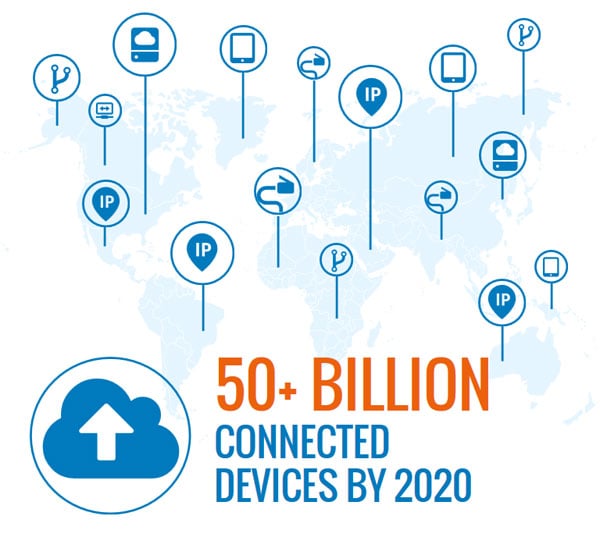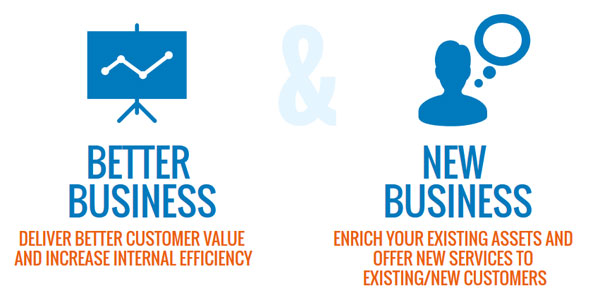
Let's start by stating the obvious:
- 1. The internet of things is here
- 2. It is here to stay
- 3. It is changing the world
In this post, we'll zoom in on the enablers of this (r)evolution, and explain why you as an individual or as a company should be on board. A lot is changing and now is the time to act!

Why is the pre-IoT world not (or no longer) efficient?
Let's start with some nostalgia (or maybe reality for some of us): think about a time, probably not too long ago, where the heating of your house was controlled by manually adjusting the valves on the radiators throughout the house. By sensing that it is too cold, or too hot, you decide to "make it warmer" or "turn off the heating" by strolling through the house and adjusting the valves accordingly.
This manual process for controlling the heating of your house is a simple example, but it in fact, many of today's business processes are (at least partly) executed in a similar way: manual interventions based on simple measurements recorded at fixed points in time. Doing your business or supporting it in this way is simply not efficient and is fast becoming an approach of the past.
To explain this in more detail, let's take a step back and look at the bigger picture.
The process of "measuring" (or "feeling" in most cases) the temperature of your house and subsequently deciding whether or not the house needs to be heated is a very common approach: not only in a home, but everywhere. Manual measurements (also known as “stating that it’s too hot or too cold”) are done and based on the outcome, decisions are taken. This is the way that things have been done for a very, very long time: entire industries have been running on this simple concept and are now starting to realize that this way of working represents an approach that is not efficient on the one hand, but also limits business opportunities on the other.
That's the case for two reasons:
1. You don't want to waste time and resources collecting data
This is best explained with an example, which is the registration of home-based usage meters (for electricity, gas and water) where an official performed a manual check every year, until it was considered too time consuming (and thus expensive). The interval of that manual process was then changed from once per year to every two years, combined with a reporting done by the customer somewhere in between of those interventions.
The inefficiency here is that precious time is spent/wasted on trivial tasks. This is time that cannot be used to do something that has actual business value. In a home context, you can easily neglect this, but in a bigger context, where staffing is involved, this can get expensive rather quickly. For years and years, the amount of measurements and the way these measurements have been done, have been optimized for an optimal balance between business need and practical considerations such as available workforce.
It is, however, important to understand that the quantity of measurable data will be growing significantly and that it just won’t be feasible anymore to manage this in a manual way. The valuable time and expertise of all people involved in the measurement process can and should be used differently. Their focus should evolve from being part of the process (including manual interventions) to improving the process.
2. Data collection frequencies are directly proportional to the number of business opportunities
If one can only get an idea of the state of a system for a limited set of points in time (cfr. reason one), then there is no way to generate a continuous flow of information -- only distinct data sets are recorded. Data that is collected at low frequencies is only suited for very specific use cases. For example, capturing the amount of electricity used in a home every year facilitates the invoice process and allows for high level reporting of electricity consumption on a yearly basis.
Capturing electricity consumption in real time enables utility providers to align electricity supply and demand by forecasting tomorrow's electricity consumption or enables customers to receive warnings regarding sudden changes in their electricity consumption (e.g. a text message saying "Hello, this is your utility provider: could it be that your fridge isn't closed properly?").
Can technology offer a solution?
As technology evolves, some fundamental and limiting barriers are being removed for collecting and analyzing streams of information:
- Measurement devices (or sensors) are becoming cheaper and easier to implement
- Devices are more easily connectable to the outside world
- A huge amount of (real time) information is being generated by these devices, allowing for process optimizations. The cost of storing measurement data (information) is decreasing and this trend will only continue
- The technology to process and analyze this huge amount of information is getting better and better, allowing for fast (real time) processing and even to perform forecasting
- The “cloud” provides virtually unlimited resources, which can be used whenever necessary. Companies don't have to invest heavily in software and infrastructure themselves, they can use the resources they need whenever they need it.
All of the elements above enable easier access to connected devices, devices that capture information and are able to share it with the rest of the world. The real power of the Internet of Things is put on display when devices (of many different kinds) are combined into connected and integrated systems. Every object or device in the physical and digital world is part of an ecosystem.
In the pre-IoT-world, a very limited number of elements in these ecosystems was able to talk to one another. The IoT-powered world integrates these elements and enables a wide range of new possibilities, services and applications that simplify our lives.
Heating a house in this IoT-powered world becomes something totally different: the intensity of heating is done based on sensors, scattered throughout the house. The heating ecosystem knows when people are home, how long it takes for the house to change its overall temperature and connects to weather forecast/measurement sources to determine when it should start to turn up/down the heat. The gas usage meter could also be part of the ecosystem, telling the heating system when prices of gas consumption are the lowest and sending gas consumption statistics to the utility provider. Based on these measurements, the gas network can be steered and optimized in real time.
In short: In the IoT-powered world manual "sensing" is no longer required to maintain a proper home temperature. Your heating system has become smart AND provides services to other parties in the ecosystem.
Okay, but why should I bother?
At this point, you might be thinking "What has this to do with me or my company?" or "This doesn’t apply to my business, it’s way too specific for that" or even "Our business is solid/profitable/strong, we don’t need to change!"
We believe that any company can benefit from applying IoT principles by:
- Doing better business: improving the way you are currently going about or supporting your business
- Doing new business: exploring and exploiting new opportunities and offering additional services

These business opportunities can be best understood by using an example: in Antwerp, a bike sharing/rental initiative called Velo was started some years ago. Velo allows its customers to pick up bicycles at locations all over the city, use them for a limited time and to drop off the bicycle at a different location.
Better business
Imagine all bicycles would be equipped with sensors capturing the current location (keeping privacy regulations in mind). This would allow Velo to know exactly where every rental bike is and where it has been in the past. Knowing current and past locations would:
- allow for the scheduling of preventive maintenance (as opposed to periodical - and thus maybe unnecessary - maintenance)
- allow for (real time) optimization of the bicycle/station network
- reduce bicycle theft: it's no longer interesting to steal a bicycle which is traced in real time
- ...
In other words: by applying IoT, the overall value of the bike sharing/rental business can be significantly increased, resulting in a better service to Velo's customers and a more (cost-) efficient internal process.
New business
Imagine that all bicycles are equipped with a sensor, measuring air pollution. I think we can all agree that registering air pollution is not an activity that is directly related to bicycle sharing. Velo has a major asset however: they've got hundreds of bicycles riding around Antwerp at all times. The cost of adding air pollution sensors to the bicycles is limited and allows for capturing real time information about the air quality in Antwerp (imagine the resources required for measuring air quality manually). This information is extremely useful for local authorities and a partnership between Velo and the city of Antwerp would be valuable to both parties.
By applying IoT to Velo's current asset (= installing connected sensors on bicycles), Velo can transform from a rental service into a provider of valuable information. Doing so, Velo could add extra services to their current offering, with limited extra costs.
We believe that Internet of Things will change the world as we know it. We believe that every company has the potential to benefit from the evolution that is enabled by the capabilities of the Internet of Things. IoT will empower you to do your current business better, exploit new business opportunities or - even better - do both.
Exploring this potential and the business opportunities it creates requires the right mindset and the right expertise. Our advice is to assemble a small group of open-minded people within your company and find a partner that facilitates, challenges and coaches. This partner should assist you in developing a clear vision of what IoT can mean for your company, in setting up a plan to execute it and in bringing together the expertise and resources to implement it.
Contact us if you are interested in discussing possible IoT solutions for your business with our AE experts.
Special thanks to Johan Moons for his help putting together this post.




